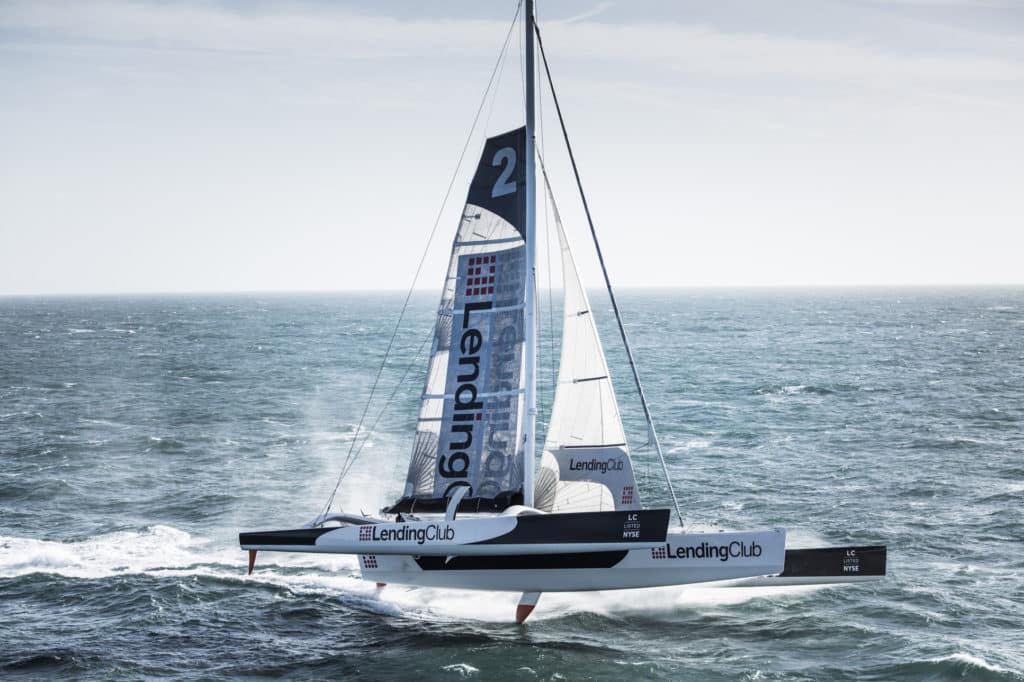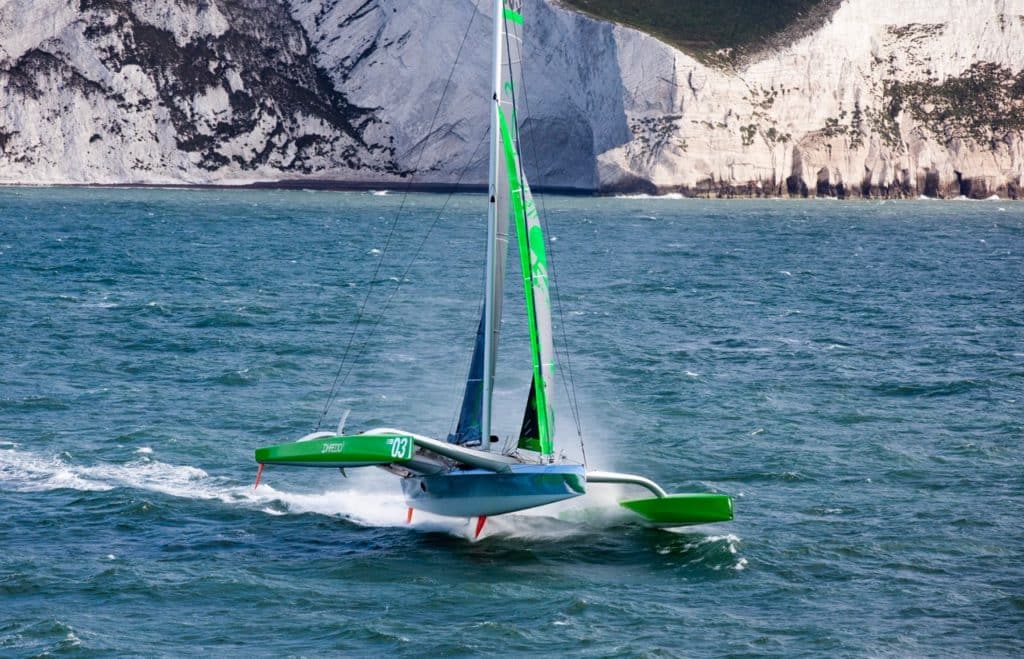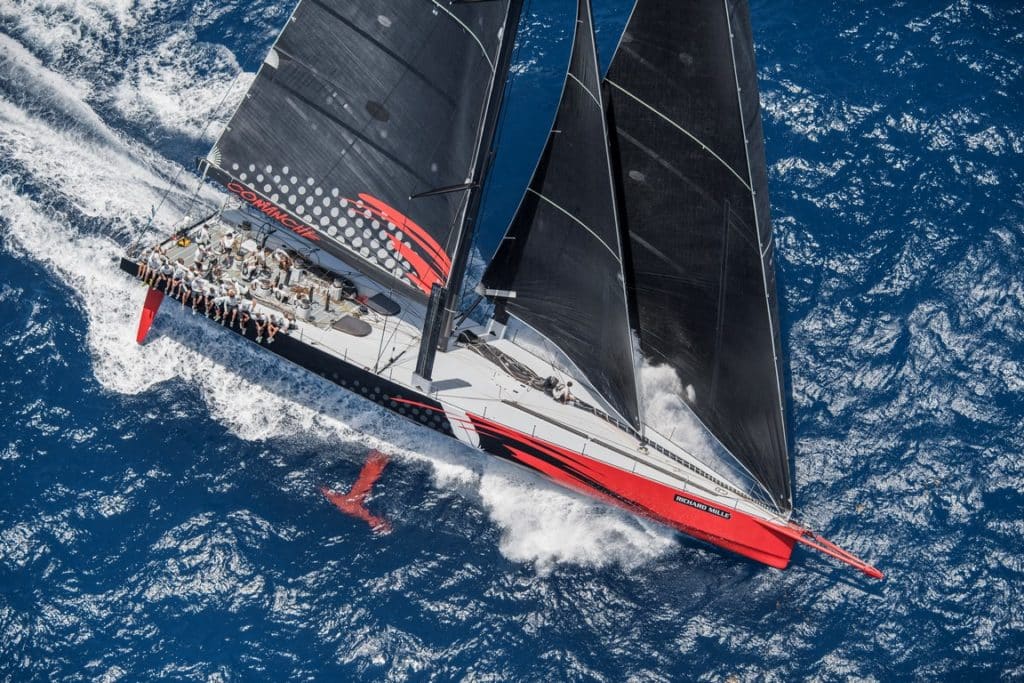Nothing directs mainstream media attention to sailing like a good accident. When Team Vestas Wind hit a reef in the Indian Ocean, the Volvo Ocean Race became a media darling. The visual of America’s Cup defender Oracle Racing’s AC72 self-destructing under the Golden Gate Bridge went viral overnight. It’s hard to beat a disaster story. But scripting such accidents is ill-advised, and not great press, either. For mainstream media, sailing also gets attention when it’s connected to another relatable experience — something rare, that involves preparation, risk and luck. We’re talking about setting and beating records.
We can all relate to records: how many days you can resist your guilty pleasure, how much time you can shave off your commute, or how many wieners a guy can scarf down in 10 minutes. There are also the more noteworthy records, like the longest free dive (200 meters), most balls juggled (11), or heaviest weight lifted with the toes (51 pounds).
Sports and records are inseparable. For a story to grab a reader’s attention, a record-setting (or -breaking) headline is a clinch. To really matter, however, the record itself must be meaningful, and that is where sailing records seem to be running off the rails.
The most egregious are the non-record records, often to serve a sponsor: A sailor secures a salary, plots a course, and seeks media coverage for a “new record” — one with no existing benchmark. Then there are those record hunters who cherry-pick from a menu of trivial times. With the fast offshore multihulls and monster monohulls of today, one can lay claim to all sorts of rarely challenged offshore passages to feign importance: “Really, you’re the fastest from San Francisco to Shanghai? Fascinating!” Lesser records steal thunder from the iconic tracks.
Established race records have likewise become murky. Why be beholden to the unfavorable weather pattern of a scheduled offshore race when you can sail the same distance at your convenience, waiting for the ideal conditions to secure fast passage? Most prominent offshore races now have two records for the same distance: the actual race record and the course record. They are two very different benchmarks. For the 2015 Transpac Race, the 105-foot trimaran Lending Club 2 excused itself from the race and left three days early, grabbing a better weather window to set a new record and diverting the race spotlight to its own program. After the MOD70 trimaran Phaedo3 finished second in the slow 2015 Fastnet Race, it returned to the course a month later to blister the record. Why take a chance and race against people when a favorable forecast can assure you a footnote in the record books?
The business of sailing records would be a real mess if not for the forethought shown in 1972 when the International Yacht Racing Union (now International Sailing Federation) established the World Sailing Speed Record Council. The council’s experience and authority ensure standards are such that new records allow for repeatable conditions, and attempts to break existing records find no shortcuts. WSSRC is the lone authority for sailing records, but not every record gets recorded. Records need substance and uniqueness, and should involve only performance. Yet there are many records in WSSRC’s book, maybe too many, recognizing solo or crewed efforts, multihull or monohull boats, etc. WSSRC will recognize gender records too, but not efforts that involve the human condition, such as age (youngest or oldest) or ability/disability. The group is expert in measuring speed, it says, while seeing measuring people as less of an exact science.
A discontinued record category is youngest nonstop, singlehanded round-the-world. After 18-year-old Jesse Martin’s 1999 circumnavigation, concerning trends emerged: The sailors were younger and their campaigns more commercial, and in some cases more reckless. But when WSSRC stepped out, all the rules did too, and teenagers who followed took shorter routes — some through the Panama Canal — than established guidelines permitted.
The alternative to WSSRC is Guinness World Records. There are no fees, but the organization lacks expertise. Any attempt submitted to GWR should be questioned, either because it was denied by WSSRC or because it lacked the relevance to warrant the fee — a requirement for record ratification. GWR also does not accept youth solo-sailing circumnavigations.
WSSRC is not in the business of maintaining endurance records, so records such as the longest distance sailed unassisted in a dinghy go to GWR. American Robert Suhay recently sailed 346.1 nautical miles in a Laser, breaking his 283.5 nm record set a year earlier. That’s certainly remarkable, but his latest effort, yet to be ratified at the time of this writing, could be disputed; the submitted distance was measured over the ground, not from point to point. Sailing in circles shouldn’t count.
Some consider this dinghy distance record to be held by Carlos Aragon of Acapulco, Mexico, who in the late 1970s purportedly sailed his Finn dinghy from Acapulco to the Marquesas Islands in French Polynesia, a distance of 2,820 nautical miles. With no authoritative ratification, however, there’s no confirmed distance.
Because records involve speed, the purest record is outright speed — the 500-meter course — but when record-seeking boardsailors found that shallow water presented a flatter and faster track, WSSRC had to dictate a minimum 10-centimeter water depth; sailing records require water. A man-made trench in southwest Africa met the rule, which is where American kiteboard innovator Rob Douglas raised the outright record to 55.65 knots in 2010.
Props to Paul Larsen, of Australia, for not setting the current outright record of 65.45 knots in a speed trench, but instead powered by a powerful offshore wind and smooth water along a shoreline. Larsen suffered numerous failures, chief among them when he went airborne and crashed in spectacular fashion, all caught on film. (Mainstream media loved it.) For four years, Larsen refined his design, leading a bare-bones pursuit. There was little glamour in his 2012 achievement, but it had heart and soul.
Another esteemed measure is the crewed round-the-world record, known as the Jules Verne Trophy. Two prominent efforts will soon seek to reduce the benchmark. However, the lineage of these efforts’ boats may be more interesting than their campaigns. Francis Joyon, of France, will lead a team on the 103-foot IDEC Sport, which was launched in 2006 as Groupama 3. On Groupama 3, Franck Cammas lowered the record in 2010 to 48d:7h:44m:52s. Dona Bertarelli and Yann Guichard will lead the other effort on board the 131-foot Spindrift 2, launched in 2008 as Banque Populaire 5. In 2012, Loick Peyron put the target to 45d:13h:42m:53s on Banque Populaire 5.
With boats of proven lineage, each crew need only survive a month and a half at a 20-knot average. Their fate lies in a weather router who decides when to cast off, but forecasts are only reliable to the equator. The torch is then handed to Mother Nature and King Neptune to determine if injury or accident will occur.
A record attempt is most pure when it’s only about the record itself. No personal gain, just the pursuit of improvement. I like the Mount Gay Rum Around Jamestown Record, a 17.8 nm course through Narragansett Bay in Rhode Island. Five categories of craft are recognized, and sailors have from Memorial Day until Oct. 31 to set the best time for the year, or, better yet, improve on the outright record. A portion of the entry fee supports community sailing, and the winners are awarded Mount Gay Rum equal to the skipper’s weight. That’s keeping it real.












